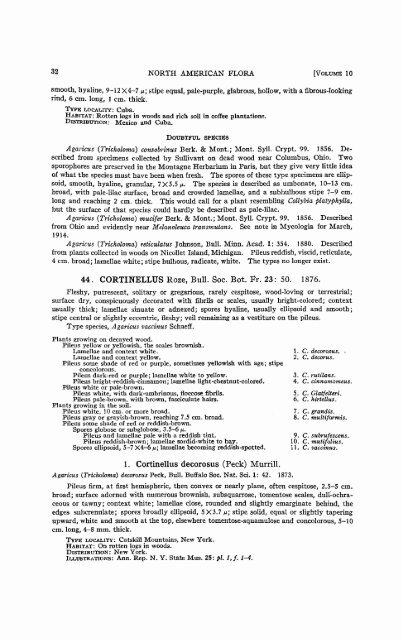North American Flora: Agaricales, Agaricaceae (Vol. 10 ... - MykoWeb
North American Flora: Agaricales, Agaricaceae (Vol. 10 ... - MykoWeb
North American Flora: Agaricales, Agaricaceae (Vol. 10 ... - MykoWeb
Create successful ePaper yourself
Turn your PDF publications into a flip-book with our unique Google optimized e-Paper software.
32 NORTH AMERICAN FLORA [VOLUME <strong>10</strong><br />
smooth, hyaline, 9-12X4-7 p; stipe equal, pale-purple, glabrous, hollow, with a fibrous-looking<br />
rind, 6 cm. long, 1 cm. thick.<br />
TYPE LOCALITY: Cuba.<br />
HABITAT: Rotten logs in woods and rich soil in coffee plantations.<br />
DISTRIBUTION: Mexico and Cuba.<br />
DOUBTFUL SPECIES<br />
Agaricus (Tricholoma) consobrinus Berk. & Mont.; Mont. Syll. Crypt. 99. 1856. De-<br />
scribed from specimens collected by Sullivant on dead wood near Columbus, Ohio. Two<br />
sporophores are preserved in the Montagne Herbarium in Paris, but they give very little idea<br />
of what the species must have been when fresh. The spores of these type specimens are ellip-<br />
soid, smooth, hyaline, granular, 7X5.5 ß. The species is described as umbonate, <strong>10</strong>-13 cm.<br />
broad, with pale-lilac surface, broad and crowded lamellae, and a subbulbous stipe 7-9 cm.<br />
long and reaching 2 cm. thick. This would call for a plant resembling Cottybia platypkylla,<br />
but the surface of that species could hardly be described as pale-lilac.<br />
Agaricus (Tricholoma) mucifer Berk. & Mont.; Mont. Syll. Crypt. 99. 1856. Described<br />
from Ohio and evidently near Melanoleuca transmutons. See note in Mycologia for March,<br />
1914.<br />
Agaricus (Tricholoma) reticulatus Johnson, Bull. Minn. Acad. 1: 354. 1880. Described<br />
from plants collected in woods on Nicollet Island, Michigan. Pileus reddish, viscid, reticulate,<br />
4 cm. broad; lamellae white; stipe bulbous, radicate, white. The types no longer exist.<br />
44. CORTINELLUS Roze, Bull. Soc. Bot. Fr. 23: 50. 1876.<br />
Fleshy, putrescent, solitary or gregarious, rarely cespitóse, wood-loving or terrestrial;<br />
surface dry, conspicuously decorated with fibrils or scales, usually bright-colored; context<br />
usually thick; lamellae sinuate or adnexed; spores hyaline, usually ellipsoid and smooth;<br />
stipe central or slightly eccentric, fleshy; veil remaining as a vestiture on the pileus.<br />
Type species, Agaricus vaccinus Schaeff.<br />
Plants growing on decayed wood.<br />
Pileus yellow or yellowish, the scales brownish.<br />
Lamellae and context white. 1. C. decorosus. ,<br />
Lamellae and context yellow. 2. C. decorus.<br />
Pileus some shade of red or purple, sometimes yellowish with age; stipe<br />
concolorous.<br />
Pileus dark-red or purple; lamellae white to yellow. 3. C. rulilans.<br />
Pileus bright-reddish-cinnamon; lamellae light-chestnut-colored. 4. C. cinnamomeus.<br />
Pileus white or pale-brown.<br />
Pileus white, with dark-umbrinous, floccose fibrils. 5. C. Glatfelteri.<br />
Pileus pale-brown, with brown, fasciculate hairs. 6. C. hirtellus.<br />
Plants growing in the soil.<br />
Pileus white, <strong>10</strong> cm. or more broad. 7. C. grandis.<br />
Pileus gray or grayish-brown, reaching 7.5 cm. broad. 8. C. multiformis.<br />
Pileus some shade of red or reddish-brown.<br />
Spores globose or subglobose, 3.5-6/4.<br />
Pileus and lamellae pale with a reddish tint. 9. C. subrufescens.<br />
Pileus reddish-brown; lamellae sordid-white to bay. <strong>10</strong>. C. mutifolius.<br />
Spores ellipsoid, 5-7 X4H5 ¡i; lamellae becoming reddish-spotted. U.C. vaccinus.<br />
1. Cortinellus decorosus (Peck) Murrill.<br />
Agaricus (Tricholoma) decorosus Peck, Bull. Buffalo Soc. Nat. Sei. 1: 42. 1873.<br />
Pileus firm, at first hemispheric, then convex or nearly plane, often cespitóse, 2.5-5 cm.<br />
broad; surface adorned with numerous brownish, subsquarrose, tomentose scales, dull-ochra-<br />
ceous or tawny; context white; lamellae close, rounded and slightly emarginate behind, the<br />
edges subcrenulate; spores broadly ellipsoid, 5X3.7 y.; stipe solid, equal or slightly tapering<br />
upward, white and smooth at the top, elsewhere tomentose-squamulose and concolorous, 5-<strong>10</strong><br />
cm. long, 4-8 mm. thick.<br />
TYPE LOCALITY: Catskill Mountains, New York.<br />
HABITAT: On rotten logs in woods.<br />
DISTRIBUTION: New York.<br />
ILLUSTRATIONS: Ann. Rep. N. Y. State Mus. 25: pi. l,f. 1-4.
















